Pickled Turnip (Senmaizuke) is a Kyoto specialty food. Thinly sliced turnip is marinated in sweet vinegar with konbu and chilli. Crunchy turnip with sweet and sour flavour – it’s great with rice and goes well with drinks as nibbles. The traditional senmaizuke uses turnip like my recipe, but you can make it with daikon (white radish) too.
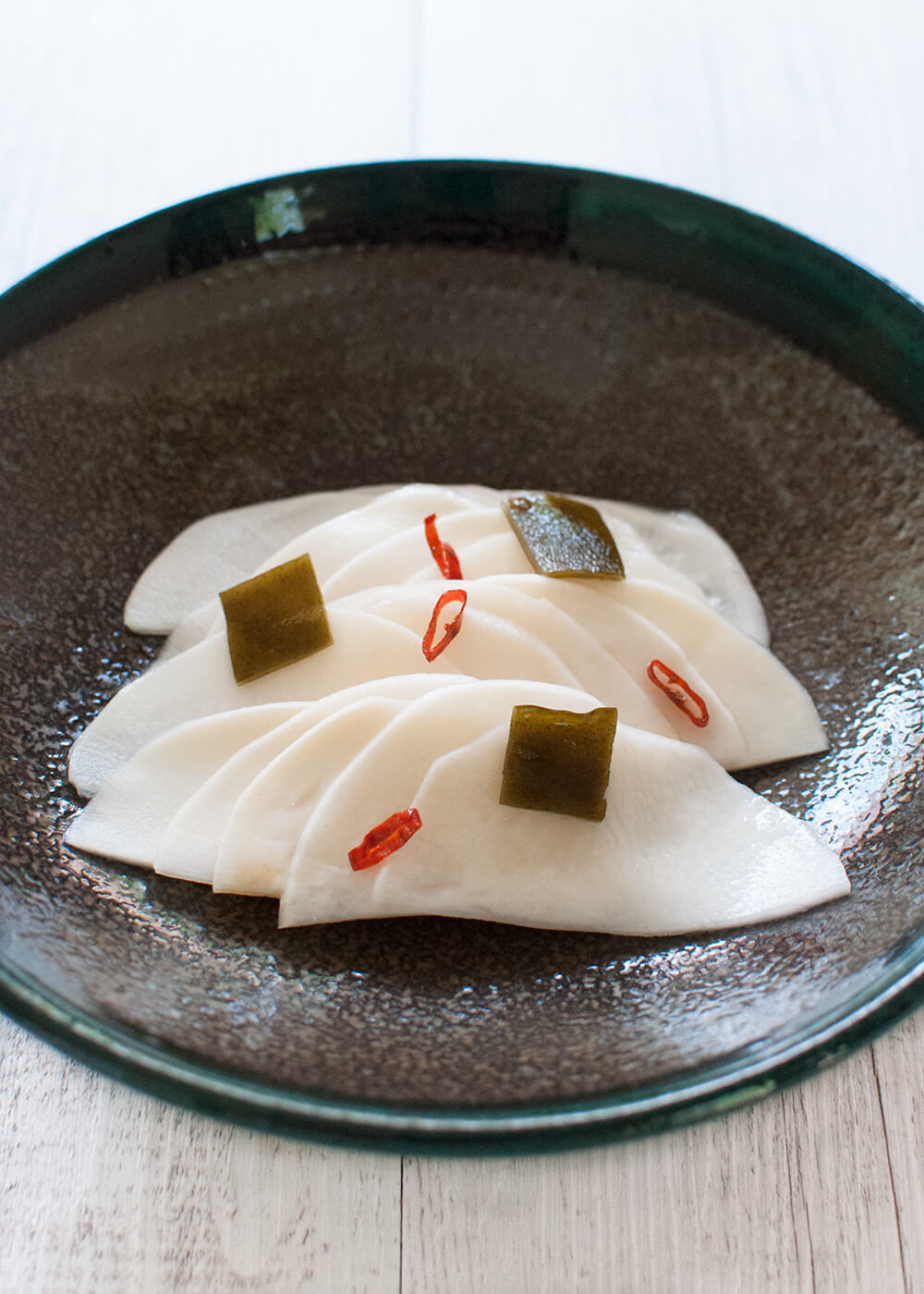
Kyoto is famous for pickles. They use local vegetables and the flavouring is delicate. The word ‘pickles’ is ‘tsukemono’ (漬物) in Japanese and the Kyoto specialty pickles made with Kyoto local vegetables are generically called ‘Kyō-tsukemono’ (京漬物), adding ‘Kyō’ from ‘Kyoto’ (京都) as a prefix. They even named vegetables produced in Kyoto – ‘Kyō-yasai’ (京野菜), meaning Kyoto vegetables.
If you walk around the market streets in Kyoto, you will find many shops selling just pickles. There are so many different kinds of pickles and you can usually taste samples before deciding what to buy, or even if you’re not intending to buy.
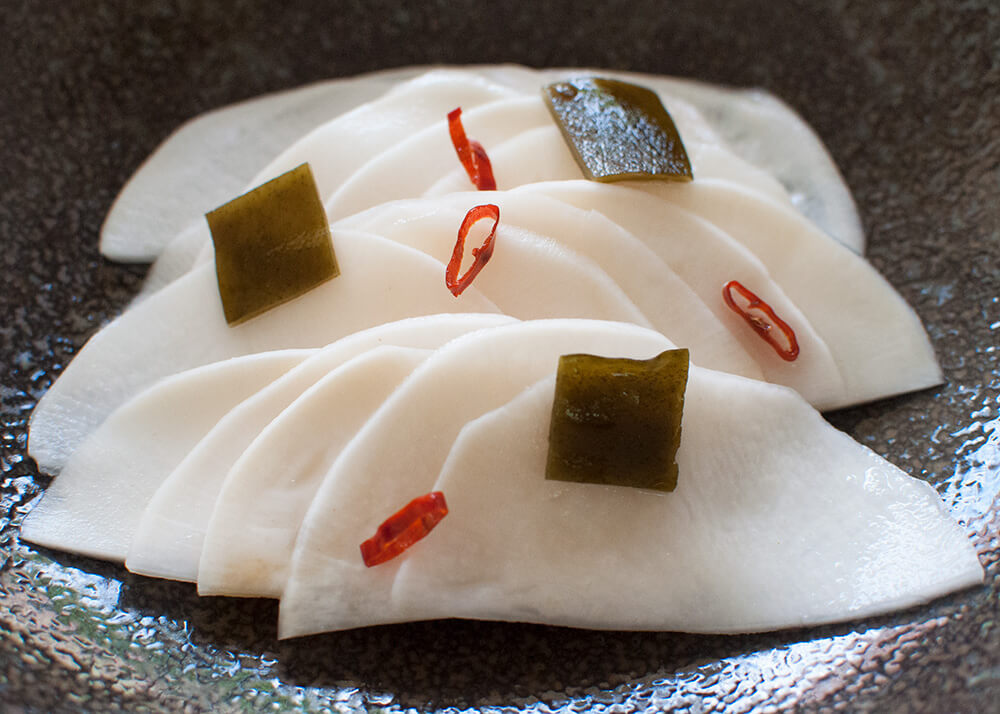
One of the three most famous Kyoto pickles is senmaizuke. The real senmaizuke uses Kyoto’s huge turnip called Shōgoin kabu (聖護院かぶ, Shōgoin turnip), which is a local vegetable of Kyoto. It is a very large turnip and its diameter is about 18-20cm (7-8”). The flesh has a fine texture, sweetness and is slightly slimy.
There are a few reasons why Kyoto has become famous for pickled vegetables. Kyoto is located in a valley that is part of the Kyoto basin. Unlike many other prefectures of Japan, Kyoto is far from the sea so people grow vegetables as a main source of food instead of fish. And to keep vegetables longer, people have to pickle them.
Kyoto’s pickled vegetables have delicate flavours in general and often look very simple. This Senmaizuke is also made in quite a simple way. You just have to be a bit patient because you will need to make it over a few days.
The specialty pickles shops make a large amount of senmaizuke by slicing Shōgoin turnip and placing the slices neatly in a large wooden barrel. The number of thinly sliced turnip amounted to over 1000 slices in a barrel, hence it was named ‘senmaizuke’ (千枚漬け), meaning a thousand sheets marinade.
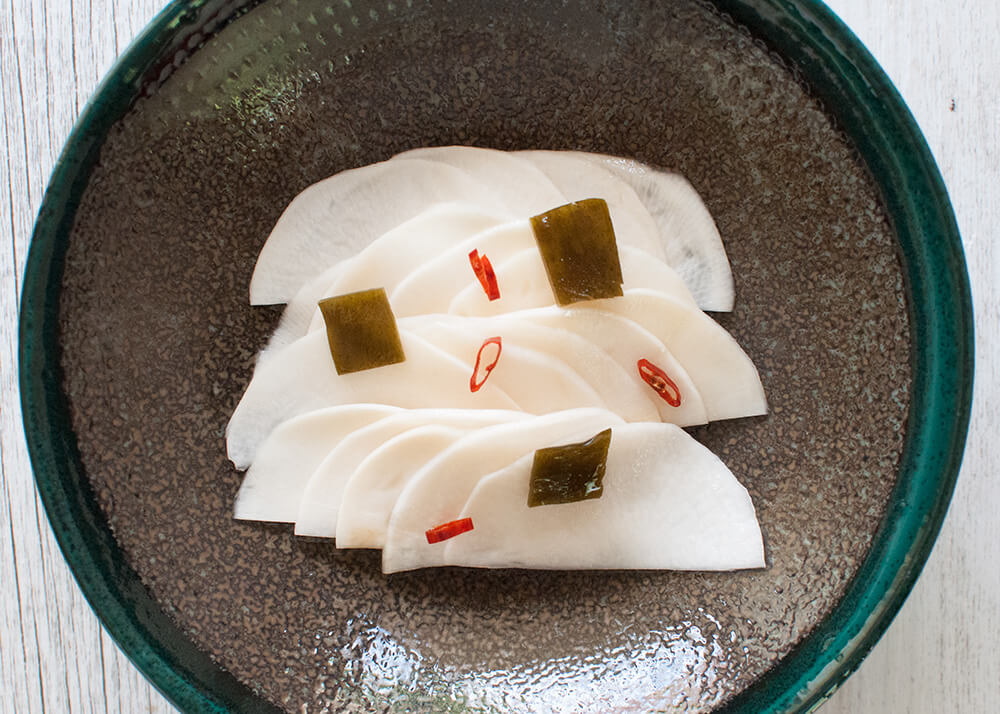
The marinade is simply a mixture of rice vinegar, mirin and sugar with pieces of konbu and chilli. But before marinating in sweet vinegar mixture, the turnip slices need to be marinated in just salt overnight. This process is called ‘shitazuke’ (下漬け, pre-marinade preparation).
The purpose of shitazuke is to extract the moisture inside the turnip slices so that when they are marinated in sweet vinegar marinade over 1-2 days, the turnip will be able to absorb the marinade better and become tastier. Salted turnips are pressed down with a weight.
After shitazuke is done, turnip slices are rinsed and placed neatly in layers in a container. Between each layer, konbu and chilli pieces are scattered with some marinade. Again, some weight is placed over the turnip slices.
I tried to lay each slice in the similar way the traditional pickle makers do. See the 2nd row of the step-by-step photo below. Aren’t they pretty? I was quite happy with the way it looks.
I used konbu produced in Rishiri (利尻), Hokkaido. It is recommended to use either Rishiri konbu or Rausu (羅臼) konbu because they contain more umami than others. Rishiri konbu also becomes slimy when water is absorbed. You can see the sliminess captured in the last photo below. This sliminess is one of the characteristics of senmaizuke. But if you use other types of konbu, that’s OK, too.
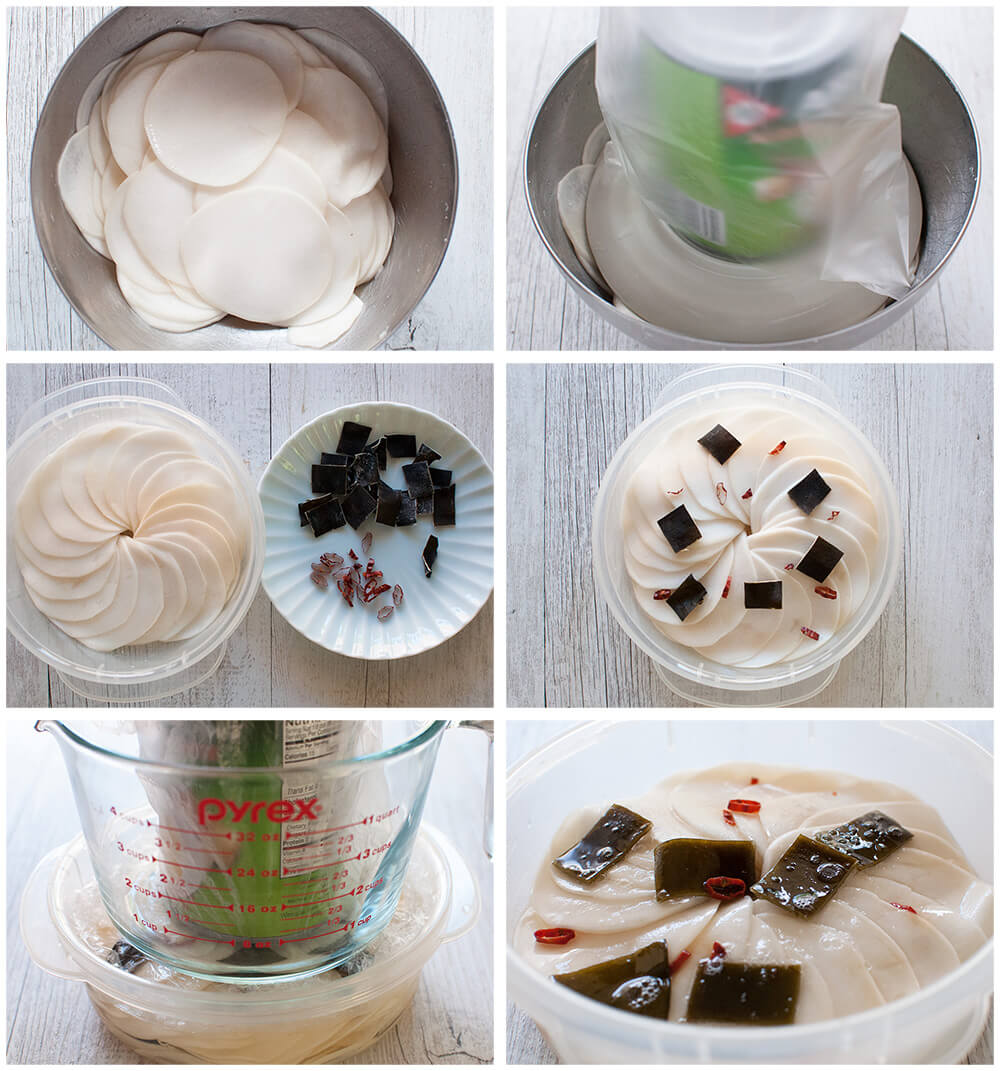
Instead of turnip, you can use daikon (white radish) if you want but the process is slightly different so I added this to the recipe. Here is Senmaizuke using daikon.
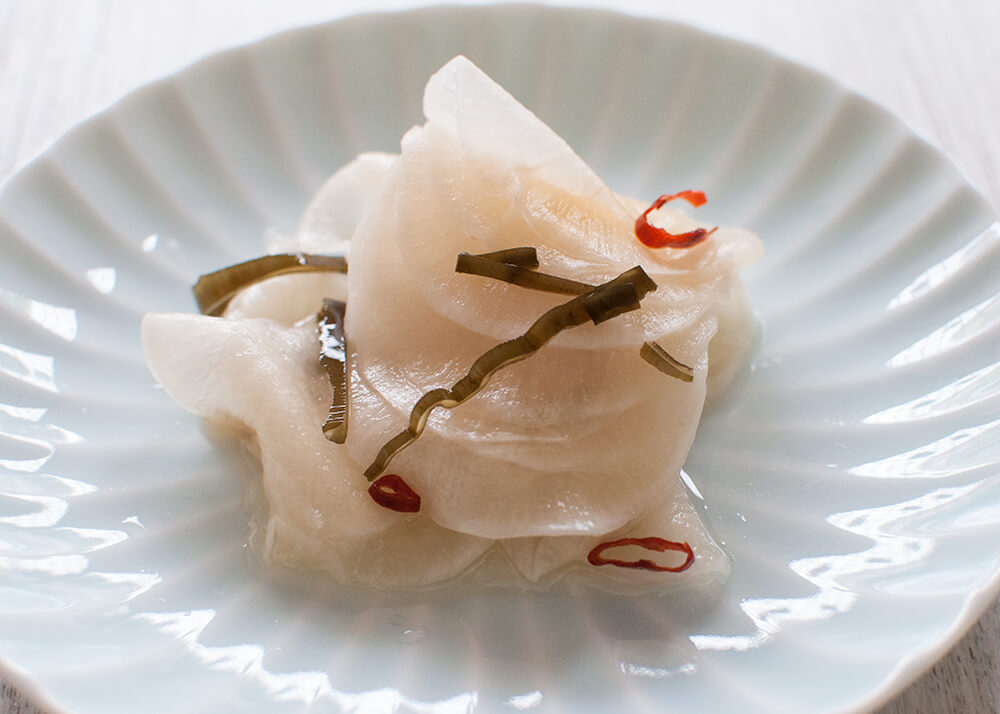
Making Pickled Turnip (Senmaizuke) takes 2-3 days but the actual time taken to prepare it is not a lot at all. Given that it keeps for a week or so in the fridge, this is a perfect pickled vegetable you can make ahead.
Yumiko![]()
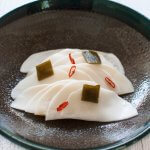
Pickled Turnip (Senmai-zuke) is a Kyoto specialty food. Thinly sliced turnip is marinated in sweet vinegar with konbu and chilli. Crunchy turnip with sweet and sour flavour - it's great with rice and goes well with drinks as nibbles. The traditional senmai-zuke uses turnip like my recipe but you can make it with daikon (white radish) too - see the notes.
Total time does not include time to marinate. You will need minimum 2 days to make it.
- 500g (1.1lb) turnip, thinly sliced to 2-3mm (1/16-⅛") thick round slices (note 1)
- ½ tbsp salt
- 8g / 10cm (0.3oz / 4”) konbu (kelp) cut into 20-25 pieces (note2)
- 1 dried red chilli , deseeded and finely chopped
- A round 16cm (6") air-tight container or similar size non-round container (note 3)
- 2 tbsp rice vinegar
- 2 tbsp mirin
- 1 tsp sugar
-
Sprinkle salt over the turnip slices in a bowl. Mix well so that salt coats each slice.
-
Place a small flat plate (slightly smaller than the surface of the turnip) upside down on the turnip, then place a large can of food of about 500g (1.1lb) in a plastic bag on it as a weight.
-
Cover with cling wrap or a large plastic bag and leave it for overnight to 24 hours in the fridge (note 4).
-
Add the Marinade ingredients to a small saucepan and heat to warm up the liquid so that sugar dissolves. Let it cool down.
-
Add water to the bowl of turnips, quickly rinse, then drain well (note 4).
-
In the air-tight container, lay a third of the turnip slices one by one, about ¾ - ⅘ overlapping each other. Adjust the overlapping amount to cover the entire bottom of the container with the turnip slices. (note 5, also see the step-by-step photo)
-
Scatter ⅓ each of konbu and chilli pieces over the turnip slices, then gently pour ⅓ of the marinade over the turnip.
-
Repeat steps 3 and 4 until all ingredients are used up.
-
Place cling wrap over the marinade so that it seals the surface of the marinade. Place a 1-1.5kg (2.2 - 3.3lb) weight with a flat bottom (or place a small flat plate underneath the weight.
-
Cover it with cling wrap or place it in a large plastic bag and leave at least overnight in the fridge. (note 6)
-
If the turnip slices are very soft, serve them by folding each slice once or twice so that they become bite sized. If not so soft, cut them into halves or quarters.
-
Place a couple of konbu and chilli pieces on top to decorate.
1. I used 3 turnips that weighed slightly more than 500g. Slice horizontally to make round slices if you have a mandolin with similar thickness.
If you don’t have a mandolin, it would be a challenge to make round thin slices. So, I would suggest that you cut a turnip vertically in half, place the half turnip on a cutting board cut side down, then slice thinly to make semi-circle slices.
You can also substitute turnip with daikon (white radish) but see note 4 for variations to the steps.
2. The majority of konbu comes from Hokkaido and the packet indicates where within Hokkaido it came from. If you have a choice, use konbu from Rishiri (利尻) or Rausu (羅臼) because they contain more umami than other konbu. It is still tasty even if you use other types of konbu, though.
You can cut konbu in any ways. I sometimes cut it into strings, instead of squares.
3. I used a 16cm round plastic container, but you can use a square or oblong shape container with a similar surface area at the bottom.
If you don’t have a similar size container, you can use a slightly larger or smaller container. The difference is how many layers of turnip slices you will end up with. My container allowed for three layers of slices which were laid overlapping each other.
4. If you are using daikon (white radish) instead of turnip, you need to marinate only a couple of hours. After rinsing, squeeze water out of daikon gently.
5. In the case of a round container like mine, place the slices around the circle so that the thickness of the layer is mostly even.
If you are using a square or oblong shape container, you will lay the slices in rows.
If you are using a container with a smaller/larger surface area, you will have more/less (respectively) layers of turnip slices. In this case, the konbu, chilli and marinade need to be divided into more/less accordingly.
6. Depending on the type of konbu used, it might produce slimy substances when marinated. This is part of the characteristics of the konbu and traditional senmai-zuke.
7. Senmai-zuke keeps about 1 week in the fridge.
I made this pickle recipe but found that the chilli was too strong and will leave it out when next I make the pickle
Hi Ted, sorry to hear that it was too spicy. I am quite sensitive to chilli but did not feel too hot in my Senmai-zuke. You can add only a few slices instead, but it will also work fine without it.
Lovely receipe, thanks heaps for sharing.
Hi Amin, glad you enjoyed it!
Hey Yumiko!
I just wanted to clarify if any preparation needs to be done for the konbu before use, or use it straight out of the packet.
Thank you!
Hi Natalia, you can use konbu straight out of the packet. Konbu might come with white substances all over but that’s umami. So, don’t wash it with water. If you feel uncomfortable, you could dust it by wiping the surface of the konbu with a towel of a paper towel, without rubbing off the white substances.
Hi Yumiko,
If using daikon instead of turnips, which part of the marinating needs only be a few hours, the pre-marinating with the salt or the actual marinating?
Thank you,
Andre
Hi Andre, Pre-marinating time is shorter if using daikon.
Why ?
Hi Orel, it’s because daikon contains much more water and you don’t need much time wilting the slices.
Yumiko-san konnichiwa and thank you for senmaizuke recipe, a favorite otsukemono of mine.
May I just ask: Under “Marinating” you write,
>Add the Marinade ingredients to a small saucepan and heat to warm up the liquid so that sugar resolves.
I think you want “dissolves”…although, in a way, “resolves” conveys the idea!
Please add a line space before “May I….”
Thanks!
Hi Sandy, oops, typo. Just fixed! Thanks for letting me know.
Japanese dishes always look so beautifully composed. Works of art using the simplest and most mundane components. Mindfulness in all things feeds the soul and the body. Thank you, Yumiko.
Hi Vivan, you summarised about Japanese dishes so well. That’s why I need to go back to Japan again and again to experience it even if I really love Australia. Of course I have siblings, too. But I am not sure which comes first – seeing my siblings vs experiencing Japanese food. (my sister will kill me!)